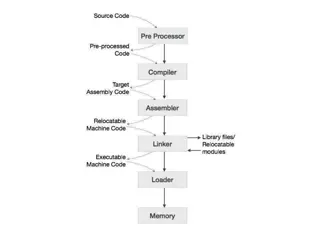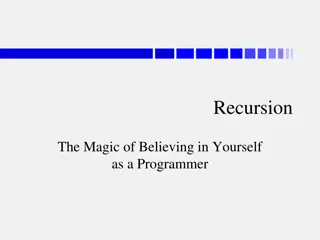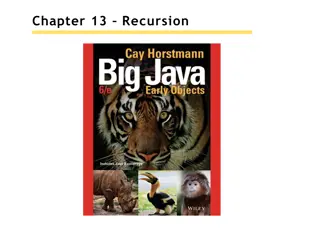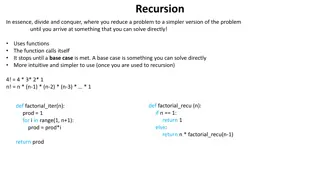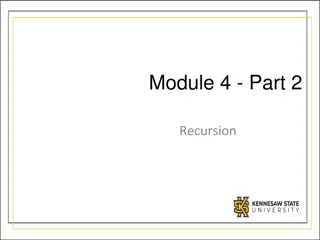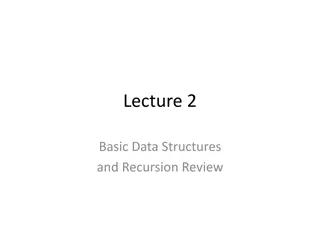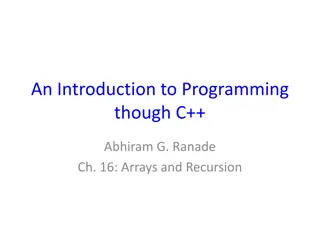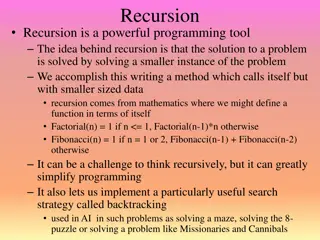RECURSION
Recursion is a fundamental concept in computer science, particularly in Java programming. This content delves into the intricacies of recursion, covering topics such as base cases, Java stack frames, function equals, and overriding function equals in a class. It explores how to define and implement the equals function in a class, specifically in the context of Animal objects. The content provides detailed explanations with code snippets and illustrations to aid in comprehension and application of recursion in Java programming.
Download Presentation

Please find below an Image/Link to download the presentation.
The content on the website is provided AS IS for your information and personal use only. It may not be sold, licensed, or shared on other websites without obtaining consent from the author.If you encounter any issues during the download, it is possible that the publisher has removed the file from their server.
You are allowed to download the files provided on this website for personal or commercial use, subject to the condition that they are used lawfully. All files are the property of their respective owners.
The content on the website is provided AS IS for your information and personal use only. It may not be sold, licensed, or shared on other websites without obtaining consent from the author.
E N D
Presentation Transcript
RECURSION Lecture 7 CS2110 Fall 2015
Overview references to sections in text 2 Note: We ve covered everything in JavaSummary.pptx! What is recursion? 7.1-7.39 slide 1-7 Base case 7.1-7.10 slide 13 How Java stack frames work 7.8-7.10 slide 28-32
Function equals 3 a0 public class Object { /** Return true iff this object is * the same as ob */ public boolean equals(Object b) { returnthis == b; } } Object equals(Object) This gives a null-pointer exception: null.equals(y) x.equals(y) is same as x == y except when x is null! x ? y ? Object Object
Overriding function equals 4 Override function equals in a class to give meaning to: these two (possibly different) objects of the class have the same values in some of their fields For those who are mathematically inclined, like any equality function, equals should be reflexive, symmetric, and transitive. Reflexive: b.equals(b) Symmetric: b.equals(c) = c.equals(b) Transitive: if b.equals(c) and c.equals(d), then b.equals(d)
Function equals in class Animal a0 5 Object publicclass Animal { /** = h is an Animal with the same values in its fields as this Animal */ publicboolean equals (Object h) { equals(Object) toString() Animal name age Animal(String, int) equals() toString() if (!(h instanceof Animal)) return false; Animal ob= (Animal) h; return name.equals(ob.name) && age == ob.age; } 1. Because of h is an Animal in spec, need the test h instanceof Animal
Function equals in class Animal a0 6 Object publicclass Animal { /** = h is an Animal with the same values in its fields as this Animal */ publicboolean equals (Object h) { equals(Object) toString() Animal name age Animal(String, int) equals() toString() if (!(h instanceof Animal)) return false; Animal ob= (Animal) h; return name.equals(ob.name) && age == ob.age; } 2. In order to be able to reference fields in partition Animal, need to cast h to Animal
Function equals in class Animal a0 7 Object publicclass Animal { /** = h is an Animal with the same values in its fields as this Animal */ publicboolean equals (Object h) { equals(Object) toString() Animal name age Animal(String, int) equals() toString() if (!(h instanceof Animal)) return false; Animal ob= (Animal) h; return name.equals(ob.name) && age == ob.age; } 3. Use String equals function to check for equality of String values. Use == for primitive types
Why cant the parameter type be Animal? a0 8 Object publicclass Animal { /** = h is an Animal with the same values in its fields as this Animal */ publicboolean equals (Animal h) { equals(Object) toString() Animal name age Animal(String, int) equals() toString() if (!(h instanceof Animal)) return false; Animal ob= (Animal) h; return name.equals(ob.name) && age == ob.age; } What is wrong with this?
Sum the digits in a non-negative integer 9 /** return sum of digits in n. * Precondition: n >= 0 */ publicstaticint sum(int n) { if (n < 10) return n; sum calls itself! // { n has at least two digits } // return first digit + sum of rest return sum(n/10) + n%10 ; } E.g. sum(7) = 7 E.g. sum(8703) = sum(870) + 3;
Two issues with recursion 10 /** return sum of digits in n. * Precondition: n >= 0 */ publicstaticint sum(int n) { if (n < 10) return n; sum calls itself! // { n has at least two digits } // return first digit + sum of rest return sum(n/10) + n%10 + ; } 1. Why does it work? How does the method executed? 2. How do we understand a given recursive method or how do we write/develop a recursive method?
Stacks and Queues 11 Stack: list with (at least) two basic ops: * Push an element onto its top * Pop (remove) top element stack grows top element 2nd element ... bottom element Last-In-First-Out (LIFO) Like a stack of trays in a cafeteria Queue: list with (at least) two basic ops: * Append an element * Remove first element First-In-First-Out (FIFO) first second last Americans wait in a line the Brits wait in a queue !
Stack Frame 12 A frame contains information about a method call: At runtime Java maintains a stack that contains frames for all method calls that are being executed but have not completed. local variables parameters a frame return info Method call: push a frame for call on stack assign argument values to parameters execute method body. Use the frame for the call to reference local variables parameters. End of method call: pop its frame from the stack; if it is a function leave the return value on top of stack.
Frames for methods sum main method in the system 13 publicstaticint sum(int n) { if (n < 10) return n; return sum(n/10) + n%10; } n ___ return info frame: publicstatic void main( String[] args) { int r= sum(824); System.out.println(r); } r ___ args ___ return info frame: ? Frame for method in the system that calls method main frame: return info
Example: Sum the digits in a non-negative integer 14 publicstaticint sum(int n) { if (n < 10) return n; return sum(n/10) + n%10; } publicstatic void main( String[] args) { int r= sum(824); System.out.println(r); } r ___ args ___ return info main Frame for method in the system that calls method main: main is then called ? system return info
Example: Sum the digits in a non-negative integer 15 publicstaticint sum(int n) { if (n < 10) return n; return sum(n/10) + n%10; } publicstatic void main( String[] args) { int r= sum(824); System.out.println(r); } 824 n ___ return info r ___ args ___ return info main Method main calls sum: ? system return info
Example: Sum the digits in a non-negative integer 16 publicstaticint sum(int n) { if (n < 10) return n; return sum(n/10) + n%10; } 82 n ___ return info publicstatic void main( String[] args) { int r= sum(824); System.out.println(r); } 824 n ___ return info r ___ args ___ return info main n >= 10 sum calls sum: ? system return info
Example: Sum the digits in a non-negative integer 17 publicstaticint sum(int n) { if (n < 10) return n; return sum(n/10) + n%10; } 8 n ___ return info 82 n ___ return info 10 publicstatic void main( String[] args) { int r= sum(824); System.out.println(r); } 824 n ___ return info r ___ args ___ return info main n >= 10. sum calls sum: ? system return info
Example: Sum the digits in a non-negative integer 18 publicstaticint sum(int n) { if (n < 10) return n; return sum(n/10) + n%10; } 8 n ___ return info 8 82 n ___ return info publicstatic void main( String[] args) { int r= sum(824); System.out.println(r); } 824 n ___ return info r ___ args ___ return info main n < 10 sum stops: frame is popped and n is put on stack: ? system return info
Example: Sum the digits in a non-negative integer 19 publicstaticint sum(int n) { if (n < 10) return n; return sum(n/10) + n%10; } 8 82 n ___ return info 10 publicstatic void main( String[] args) { int r= sum(824); System.out.println(r); } 824 n ___ return info r ___ args ___ return info main Using return value 8 stack computes 8 + 2 = 10 pops frame from stack puts return value 10 on stack ? return info
Example: Sum the digits in a non-negative integer 20 publicstaticint sum(int n) { if (n < 10) return n; return sum(n/10) + n%10; } publicstatic void main( String[] args) { int r= sum(824); System.out.println(r); } 10 824 n ___ return info 14 r ___ args ___ return info main Using return value 10 stack computes 10 + 4 = 14 pops frame from stack puts return value 14 on stack ? return info
Example: Sum the digits in a non-negative integer 21 publicstaticint sum(int n) { if (n < 10) return n; return sum(n/10) + n%10; } publicstatic void main( String[] args) { int r= sum(824); System.out.println(r); } 14 r ___ args __ return info 14 main Using return value 14 main stores 14 in r and removes 14 from stack ? return info
Summary of method call execution 22 Memorize this! 1. A frame for a call contains parameters local variables and other information needed to properly execute a method call. 2. To execute a method call: push a frame for the call on the stack, assign values to parameters, execute method body, pop frame for call from stack, and (for a function) push returned value on stack When executing method body look in frame for call for parameters and local variables.
Questions about local variables 23 public static void m( ) { while ( ) { int d= 5; } } public static void m( ) { int d; while ( ) { d= 5; } } In a call m() when is local variable d created and when is it destroyed? Which version of procedure m do you like better? Why?
Recursion is used extensively in math 24 Math definition of n factorial E.g. 3! = 3*2*1 = 6 0! = 1 n! = n * (n-1)! for n > 0 Easy to make math definition into a Java function! Math definition of bc for c >= 0 b0 = 1 bc = b * bc-1 for c > 0 publicstaticint fact(int n) { if (n == 0) return 1; return n * fact(n-1); } Lots of things defined recursively: expression grammars trees . We will see such things later
Two views of recursive methods 25 How are calls on recursive methods executed? We saw that. Use this only to gain understanding / assurance that recursion works How do we understand a recursive method know that it satisfies its specification? How do we write a recursive method? This requires a totally different approach. Thinking about how the method gets executed will confuse you completely! We now introduce this approach.
Understanding a recursive method 26 Step 1. Have a precise spec! Step 2. Check that the method works in the base case(s): Cases where the parameter is small enough that the result can be computed simply and without recursive calls. /** = sum of digits of n. * Precondition: n >= 0 */ publicstaticint sum(int n) { if (n < 10) return n; If n < 10 then n consists of a single digit. Looking at the spec we see that that digit is the required sum. // n has at least two digits return sum(n/10) + n%10 ; }
Understanding a recursive method /** = sum of digits of n. * Precondition: n >= 0 */ publicstaticint sum(int n) { if (n < 10) return n; 27 Step 1. Have a precise spec! Step 2. Check that the method works in the base case(s). Step 3. Look at the recursive case(s). In your mind replace each recursive call by what it does according to the method spec and verify that the correct result is then obtained. return sum(n/10) + n%10; // n has at least two digits return sum(n/10) + n%10 ; } return (sum of digits of n/10) + n%10; // e.g. n = 843
Understanding a recursive method /** = sum of digits of n. * Precondition: n >= 0 */ publicstaticint sum(int n) { if (n < 10) return n; 28 Step 1. Have a precise spec! Step 2. Check that the method works in the base case(s). // n has at least two digits return sum(n/10) + n%10 ; } Step 3. Look at the recursive case(s). In your mind replace each recursive call by what it does acc. to the spec and verify correctness. Step 4. (No infinite recursion) Make sure that the args of recursive calls are in some sense smaller than the pars of the method. n/10 < n
Understanding a recursive method 29 Step 1. Have a precise spec! Important! Can t do step 3 without it Step 2. Check that the method works in the base case(s). Step 3. Look at the recursive case(s). In your mind replace each recursive call by what it does according to the spec and verify correctness. Once you get the hang of it this is what makes recursion easy! This way of thinking is based on math induction which we will see later in the course. Step 4. (No infinite recursion) Make sure that the args of recursive calls are in some sense smaller than the pars of the method
Writing a recursive method 30 Step 1. Have a precise spec! Step 2. Write the base case(s): Cases in which no recursive calls are needed Generally for small values of the parameters. Step 3. Look at all other cases. See how to define these cases in terms of smaller problems of the same kind. Then implement those definitions using recursive calls for those smaller problems of the same kind. Done suitably point 4 is automatically satisfied. Step 4. (No infinite recursion) Make sure that the args of recursive calls are in some sense smaller than the pars of the method
Examples of writing recursive functions 31 For the rest of the class we demo writing recursive functions using the approach outlined below. The java file we develop will be placed on the course webpage some time after the lecture. Step 1. Have a precise spec! Step 2. Write the base case(s). Step 3. Look at all other cases. See how to define these cases in terms of smaller problems of the same kind. Then implement those definitions using recursive calls for those smaller problems of the same kind.
The Fibonacci Function 32 Mathematical definition: fib(0) = 0 fib(1) = 1 fib(n) = fib(n 1) + fib(n 2) n 2 two base cases! Fibonacci sequence: 0 1 1 2 3 5 8 13 Fibonacci (Leonardo Pisano) 1170-1240? /** = fibonacci(n). Pre: n >= 0 */ staticint fib(int n) { if (n <= 1) return n; // { 1 < n } return fib(n-2) + fib(n-1); } Statue in Pisa Italy Giovanni Paganucci 1863
Check palindrome-hood 33 A String palindrome is a String that reads the same backward and forward. A String with at least two characters is a palindrome if (0) its first and last characters are equal and (1) chars between first & last form a palindrome: have to be the same e.g. AMANAPLANACANALPANAMA have to be a palindrome A recursive definition!
Example: Is a string a palindrome? 34 /** = "s is a palindrome" */ public static boolean isPal(String s) { if (s.length() <= 1) return true; // { s has at least 2 chars } int n= s.length()-1; return s.charAt(0) == s.charAt(n) && isPal(s.substring(1,n)); } Substring from s[1] to s[n-1] isPal( racecar ) returns true isPal( pumpkin ) returns false
A man a plan a caret a ban a myriad a sum a lac a liar a hoop a pint a catalpa a gas an oil a bird a yell a vat a caw a pax a wag a tax a nay a ram a cap a yam a gay a tsar a wall a car a luger a ward a bin a woman a vassal a wolf a tuna a nit a pall a fret a watt a bay a daub a tan a cab a datum a gall a hat a fag a zap a say a jaw a lay a wet a gallop a tug a trot a trap a tram a torr a caper a top a tonk a toll a ball a fair a sax a minim a tenor a bass a passer a capital a rut an amen a ted a cabal a tang a sun an ass a maw a sag a jam a dam a sub a salt an axon a sail an ad a wadi a radian a room a rood a rip a tad a pariah a revel a reel a reed a pool a plug a pin a peek a parabola a dog a pat a cud a nu a fan a pal a rum a nod an eta a lag an eel a batik a mug a mot a nap a maxim a mood a leek a grub a gob a gel a drab a citadel a total a cedar a tap a gag a rat a manor a bar a gal a cola a pap a yaw a tab a raj a gab a nag a pagan a bag a jar a bat a way a papa a local a gar a baron a mat a rag a gap a tar a decal a tot a led a tic a bard a leg a bog a burg a keel a doom a mix a map an atom a gum a kit a baleen a gala a ten a don a mural a pan a faun a ducat a pagoda a lob a rap a keep a nip a gulp a loop a deer a leer a lever a hair a pad a tapir a door a moor an aid a raid a wad an alias an ox an atlas a bus a madam a jag a saw a mass an anus a gnat a lab a cadet an em a natural a tip a caress a pass a baronet a minimax a sari a fall a ballot a knot a pot a rep a carrot a mart a part a tort a gut a poll a gateway a law a jay a sap a zag a fat a hall a gamut a dab a can a tabu a day a batt a waterfall a patina a nut a flow a lass a van a mow a nib a draw a regular a call a war a stay a gam a yap a cam a ray an ax a tag a wax a paw a cat a valley a drib a lion a saga a plat a catnip a pooh a rail a calamus a dairyman a bater a canal Panama 35
Example: Count the es in a string 36 /** = number of times c occurs in s */ publicstaticint countEm(char c String s) { if (s.length() == 0) return 0; substring s[1..] i.e. s[1] s(s.length()-1) // { s has at least 1 character } if (s.charAt(0) != c) return countEm(c s.substring(1)); // { first character of s is c} return 1 + countEm (c s.substring(1)); } countEm( e it is easy to see that this has many e s ) = 4 countEm( e Mississippi ) = 0





